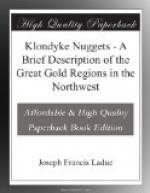“Twenty-two and a half miles from Stewart River another and larger creek enters from the same side; it agrees with the descriptions of Sixty Mile Creek, and I have so marked it on my map. This stream is of no importance, except for what mineral wealth may be found on it.[11]
[Footnote 11: Sixty Mile Creek is about one hundred miles long, very crooked, with a swift current and many rapids, and is therefore not easy to ascend.
Miller, Glacier, Gold, Little Gold and Bedrock Creeks are all tributaries of Sixty Mile. Some of the richest discoveries in gold so far made in the interior since 1894 have been upon these creeks, especially has this been the case upon the two first mentioned. There is a claim upon Miller Creek owned by Joseph Boudreau from which over $100,000 worth of gold is said to have been taken out.
Freight for the mines is taken up Forty Mile Creek in summer for a distance of 30 miles, then portaged across to the heads of Miller and Glacier Creeks. In the winter it is hauled in by dogs.
The trip from Cudahy to the post at the mouth of Sixty Mile River is made by ascending Forty Mile River a small distance, making a short portage to Sixty Mile River and running down with its swift current. Coming back on the Yukon, nearly the whole of the round trip is made down stream.
Indian Creek enters the Yukon from the east about 30 miles below Sixty Mile. It is reported to be rich in gold, but owing to the scarcity of supplies its development has been retarded.
At the mouth of Sixty Mile Creek a townsite of that name is located, it is the headquarters for upwards of 100 miners and where they more or less assemble in the winter months.
Messrs. Harper & Co. have a trading post and a saw-mill on an island at the mouth of the creek; both, of which are in charge of Mr. J. Ladue, one of the partners of the firm, and who was at one time in the employ of the Alaska Commercial Company.]
“Six and a half miles above Port Reliance the Thron-Diuck[12] River of the Indians (Deer River of Schwatka) enters from the east. It is a small river about forty yards wide at the mouth, and shallow; the water is clear and transparent, and of beautiful blue color. The Indians catch great numbers of salmon here. They had been fishing shortly before my arrival, and the river, for some distance up, was full of salmon traps.
[Footnote 12: Dawson City is situated at the mouth of the Thron-Diuck now known as Klondyke, and although it was located only a few months ago it is the scene of great activity. Very rich deposits of gold have been lately found on Bonanza Creek and other affluents of the Thron-Diuck.]
“A miner had prospected up this river for an estimated distance of forty miles, in the season of 1887. I did not see him, but got some of his information at second hand. The water being so beautifully clear I thought it must come through a large lake not far up; but as far as he had gone no lakes were seen. He said the current was comparatively slack, with an occasional ‘ripple’ or small rapid. Where he turned back the river is surrounded by high mountains, which were then covered with snow, which accounts for the purity and clearness of the water.




